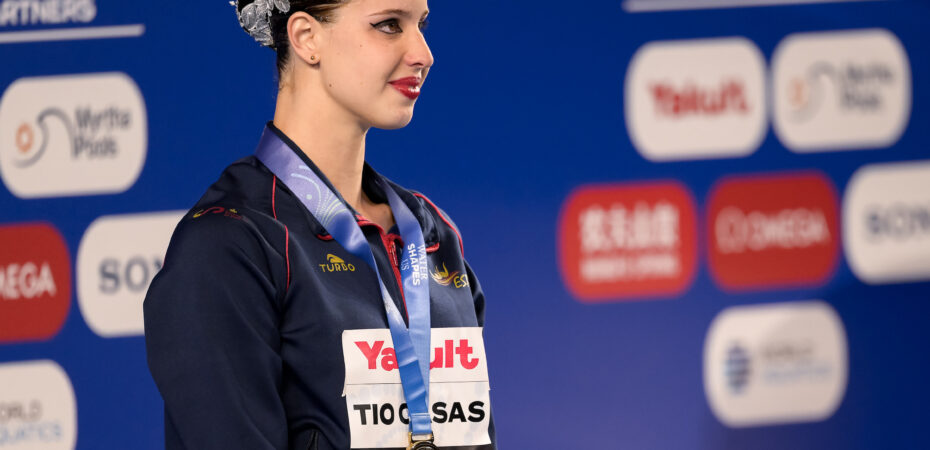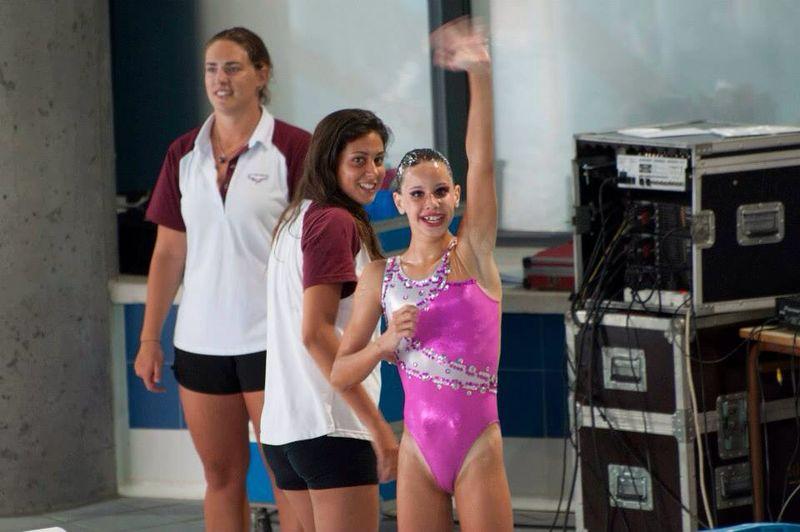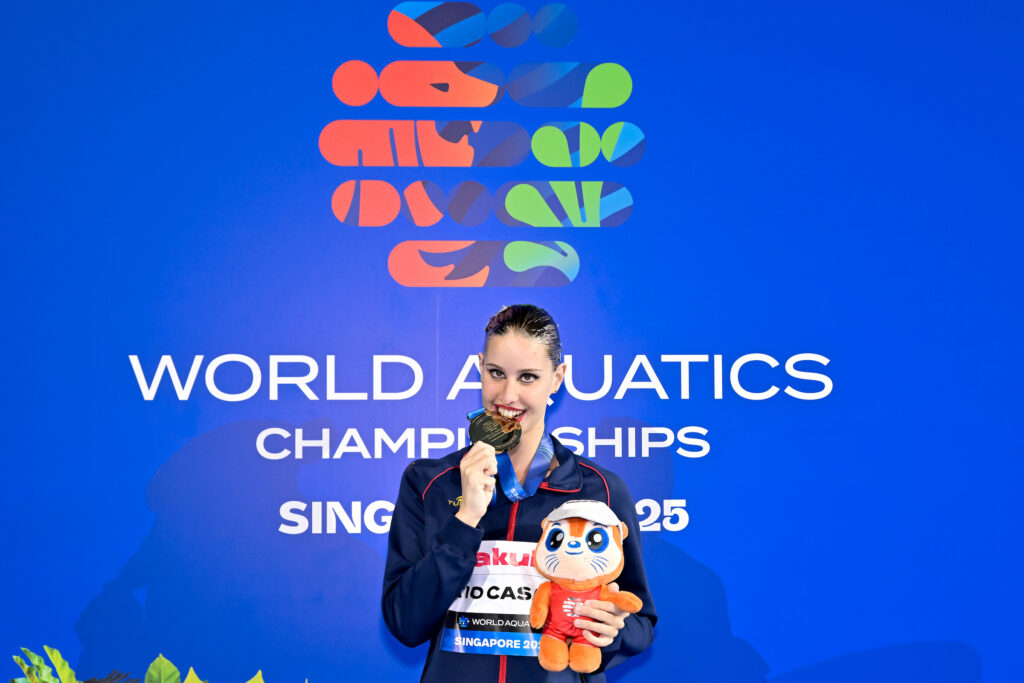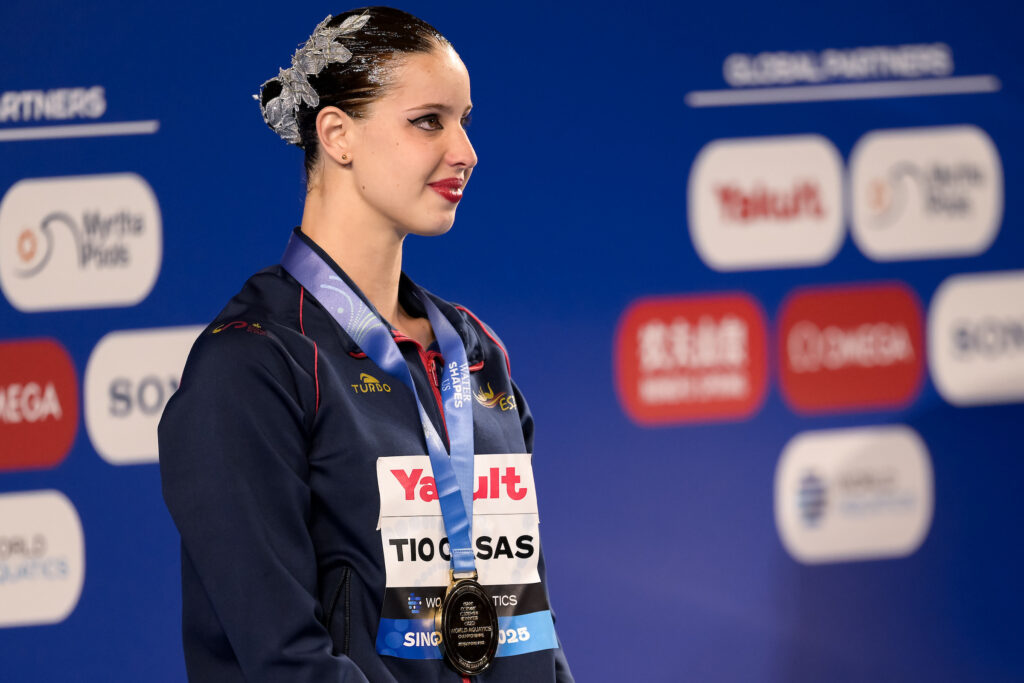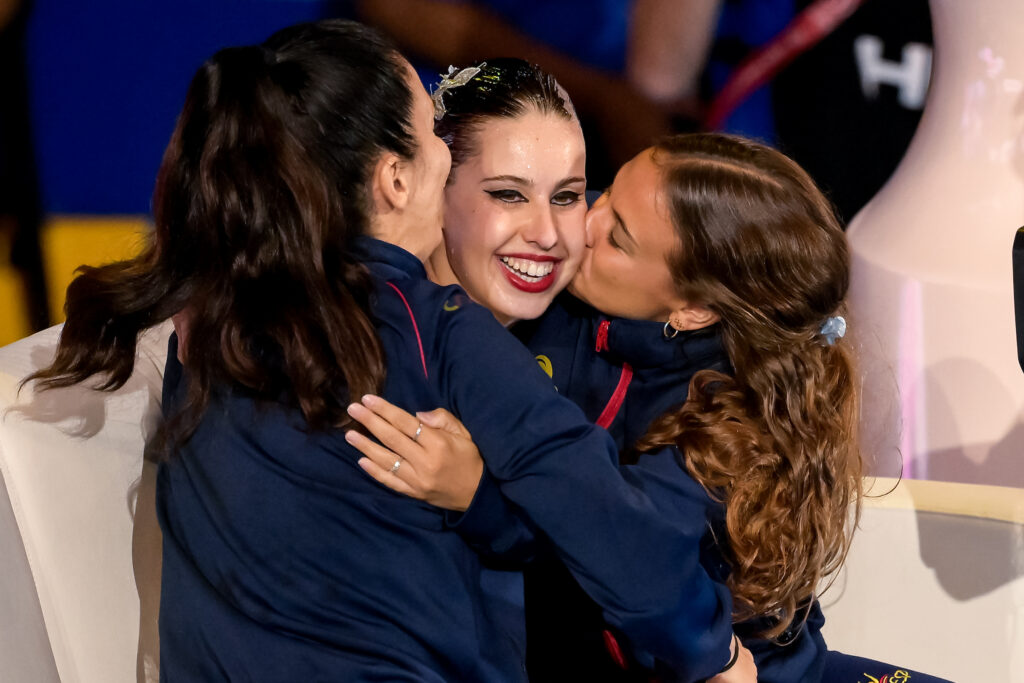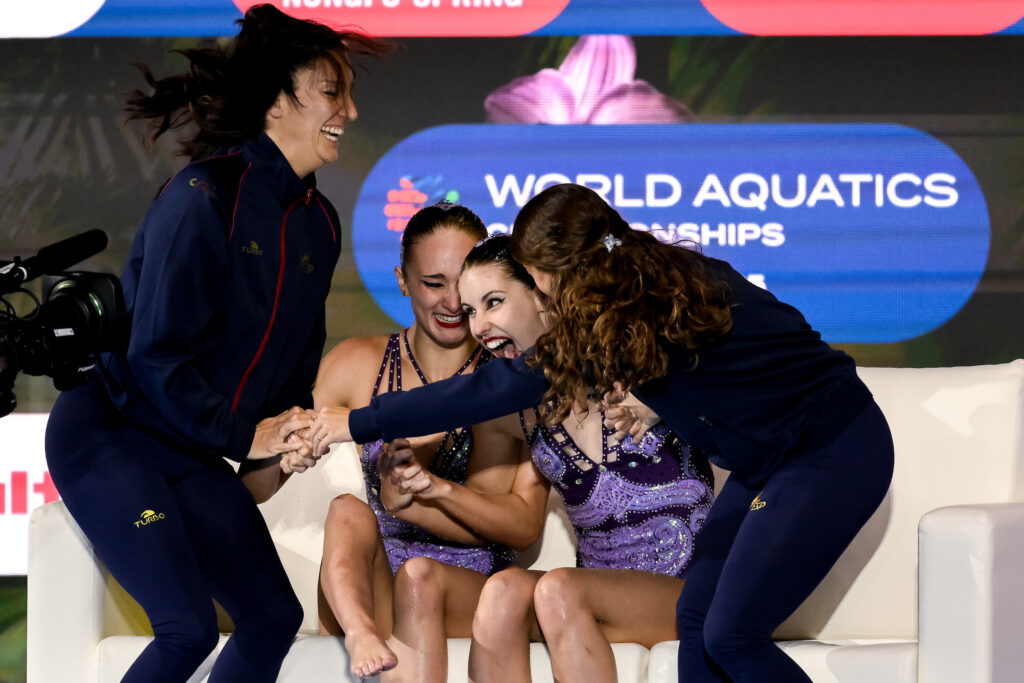July 2025 will be a month Iris Tió Casas remembers for the rest of her life. In Singapore, the 22-year-old emerged from the pool at the World Aquatics Championships with three gold medals — free solo, free duet and free mixed duet — and three bronzes, as well as the award for best female artistic swimmer.
She returned home having done something unprecedented in the sport: become a World Champion in all four disciplines — solo, duet, mixed duet, and team (the latter from Fukuoka 2023). No other athlete had ever medaled in all four at the World Championships, let alone claimed gold in each. She achieved, in every sense, an “Artistic Swimming Grand Slam” of sorts.
For Tió, these World Championships were the sorts that recalibrate a career, that mark a before and after in any athletes’ life. While most of her teammates stayed in Asia for a few days of vacation, she went straight back to Spain, diving into TV appearances, interviews, and photo shoots, hoping to keep the momentum going and give her sport the visibility it often lacked.
Two months on, the attention has barely faded, and the full weight of what she achieved is still sinking in.
“I’m still super happy,” Tió said, laughing. “I don’t think I realize what happened yet. Maybe by the time I retire, I’ll understand it all.”
The spotlight may be new, but it seemed inevitable over the years. There has been nothing accidental about her success. Nor about the way she moves, about her musical sensitivity, and her ability to perfectly swim on notes.
Born in Barcelona in the fall of 2002, Tió grew up surrounded by music and art. Her parents had met at the prestigious Guildhall School of Music and Drama in London, and built careers as violinist and clarinetist. Her grandfather was a painter, her grandmother composed electronic music.
“I have heard music, especially classical music, since I was very little. I’d start dancing in the living room all the time. Above all, I’ve always felt the music. I feel it deep inside.”
She tried clarinet, violin and piano herself, but couldn’t sit still long enough. She wanted movement. One fateful day, she saw legendary Spanish soloist Gemma Mengual on television, and she was hooked. Artistic swimming had everything she loved: music, dance and water.
She joined the storied Catalan club of C.N. Kallipolis, hoping to follow in Mengual’s footsteps. At 11 years old, she became Spanish Champion for the first time. It was right then that she started dreaming of being the champion of the world, too.
She first knocked on the door of the senior level in 2018 at the European Championships in Glasgow, as a 15-year-old junior called up when a spot in the solo event opened up. She held her own, placing fourth and already showing signs of the potential that lay ahead.
“It was super special for me. I was watching our national team, everybody under the water, I was very excited to be there.”
Seven years later, Tió is now the undisputed leader of the national team. Two-time Olympian, Olympic bronze medalist, four-time World Champion, 12-time world medalist, and six-time European Champion.
“I am very happy for that little 11-year-old girl who dreamed,” she said, smiling.
Tió’s rise has been shaped by the icons she once admired. She moved through the age groups in the shadow of Spanish synchro royalty — Gemma Mengual, but also Ona Carbonell and Andrea Fuentes, current head coach of the national team. Each has left a mark.
“Gemma was my inspiration when I was young. Everything she did, I loved it. And now, she’s one of my coaches. She helps me a lot with the entrance and deckwork for my solo, which is very hard for me.”
Ona Carbonell, with whom she competed at the Tokyo Olympics, taught her the now-famous ‘unbalanced’ move, before the rule changes and back when it belonged only to soloists.
And coach Andrea Fuentes is a daily inspiration, both in and out of the pool.
“I’m learning from her every day. I like how she lives life. She’s free, intelligent, and she respects me. Training with her feels comfortable; knowing she loves me and won’t judge me, even if I make mistakes, gives me a lot of confidence. Before, I was always focused on what I needed to improve. Andrea wants us to focus on what’s good in us, and make the most of it so it shines.”
One of their main goals this season has been to help Tió discover her own artistic voice. Previous national team coach Mayuko Fujiki introduced her to a wide variety of styles, giving her the foundation to experiment and explore. With Fuentes, that exploration is becoming sharper, clearer, unmistakably hers.
Fuentes doesn’t coach in the usual sense; she guides, she listens, and she gives her athletes space to find a line that feels true. Sometimes finding that line means resisting imitation and trusting your instincts.
“Once, we were doing choreography and I did a movement that was a bit like Gemma. Andrea said, ‘Please no, this is too much Gemma Mengual!’ (laughs) It is not easy because I’ve spent my whole life watching videos of Gemma, and Ona. But Andrea wants me to find my own style, and that’s what we did this year. I’m grateful for that. I discovered a lot, but I’m still learning about who I am, and what my style really is.”
Outside of the water, Tió is very shy and would rather not draw attention to herself. In the water, she flips a switch, commanding the pool completely and filling it with presence and confidence.
That contrast is part of what takes a viewer’s breath away, what gives her routines their electricity, and what is helping her carve out her identity as an artistic swimmer.
“Inside the water, I try not to be shy because it looks worse if you’re embarrassed, like you’re shrinking. When you do it with your whole heart, it looks better. So I always try to do every movement as if I was dancing alone in my room.”
On paper, Tió has already surpassed the names that came before her. But she is intent on paving her own way in a sport that has drastically changed in recent years. She wants to be for younger swimmers what her idols were for her, proof that you can be both creative and competitive, both daring and authentic.
It’s a mindset she carried with her to Singapore, where that quiet confidence had settled firmly within her.
“In Singapore, I was really looking forward to competing because I felt very confident in myself, eager to do well, because I didn’t have any fear. It was really cool.”
Tió came in as Spain’s leader but not necessarily as the favorite, particularly in the solo events. A few days after taking bronze in technical solo and in free team, she placed third in the free solo preliminaries, facing athletes who focused exclusively on that while she was entered in six events.
And yet, it was her who stood at the top of the podium that day, tearing up as the national anthem played for her.
“I didn’t expect the solo gold at all. After the preliminaries, I saw others had increased their difficulty a lot. I did too, but not as much. I was confident in my choreography, and just wanted to show the artistry, my expressive arms. Of course, I was hoping for a medal, but I wanted to really enjoy it as much as possible. I was shocked when I saw the result.”
All season, the Spanish athletes and coaches had deliberately focused on artistic impression, holding back on difficulty while other teams piled it on. It was a conscious gamble, to see if strong artistry could be enough. But by midseason it became clear that to fight for medals, they would still have to raise the bar without losing their identity.
For Tió’s free solo, the turning point came after the European Championships and the World Cup Super Final. Fuentes sensed her swimmer was running on fumes and gave her an unusual gift only 15 days away from the World Championships: a week off.
So instead of grinding through fatigue, Tió rested and reflected. When she returned, she and assistant coach Judit Requena went to work, searching for movements that would add difficulty without increasing apnea time.
“We didn’t want to put difficulty just to put it. We wanted to keep great choreography too. We competed and learned a lot this season, so I felt I was ready to take that risk. From then on, we achieved a difficulty that we knew would compete for medals without taking away anything from the artistry.”
That was the key, and Tió’s routine was ultimately the right balance of high difficulty and outstanding artistic impression. That allowed her to achieve something no other Spanish soloist had ever done before her: become a World Champion in that event.
This process also turned into something more for her.
“Each medal [from Singapore] is special, but the gold in free solo is especially meaningful because of the connection I had with Judit. In those last weeks, I trained with her a lot. We created a really good team, I didn’t feel alone swimming solo.”
Later that day, the momentum kept going as she won a third bronze in the technical team routine. Now, the duet and mixed duet events awaited.
Tió’s duet with Lilou Lluis was also untested at this level. Although the two were teammates in the Paris Games, this had been their very first season in duet together, an opportunity granted by Fuentes at the beginning of the year, wanting to try out different pairings.
The pair had placed first in the preliminaries, but this gold was just as unexpected for Tió.
“It was the first time we swam together at a very important championship, but I trust a lot in Lilou. We have a really good chemistry, and we laugh a lot in training together. It’s a pleasure to swim with her. During the routine, we focus on small goals, without pressure, one after the other. We were super happy because we didn’t expect it at all in only our first year together.”
Tió also made her mixed duet debut this season, swimming alongside Dennis González Boneu. The two went undefeated all season and were the heavy favorites heading into Singapore, but they didn’t take anything for granted either.
“We felt a little bit of pressure because the athletes from Russia were back and we hadn’t seen them in a long time. But like with Lilou, we tried to focus on the present, step by step, and enjoy. When we put a lot of our emotions into the routine, it’s how we do our best. And it worked. It’s been a very beautiful process.”
Just like her solo gold, the victories in both the duet and the mixed duet marked firsts for Spain at a World Championships, historic milestones that cemented Tió’s place not only as a standout soloist but as a leader across every discipline she touches.
And yet, despite these historic milestones, two Olympic appearances and a mountain of World and European medals, she still feels at the start of something.
“I am still young, I will be 23 in November. My body feels fine, I feel good mentally and physically. I don’t feel I have to take a break yet. I am ready for new challenges.”
Tió’s 2025 season was a proof of concept: that sensitivity to music, a fearless willingness to take risks, and a coach who asks her to be herself can be combined into something unprecedented.
She has the medals and now, perhaps more valuable, the confidence to keep pushing boundaries. She speaks of competing in LA 2028, of making history for artistic swimming in Spain, of becoming the “Rafa Nadal of synchro”, and of doing things “that never [have been] achieved before.”
But what she keeps returning to is simpler, truer. What she wants now is not just results, but resonance.
“I hope people remember me not only for the results, but for the feeling they get when they see me swimming. That they have goosebumps, and that they enjoy watching me.”
If that is her ambition, Singapore was not the finale but the first clear marker of what is still to come.
ARTICLE BY CHRISTINA MARMET
Cover photo: Giorgio Scala / Deepbluemedia
If you’ve enjoyed our coverage, please consider donating to Inside Synchro! Any amount helps us run the site and travel costs to cover meets during the season.

